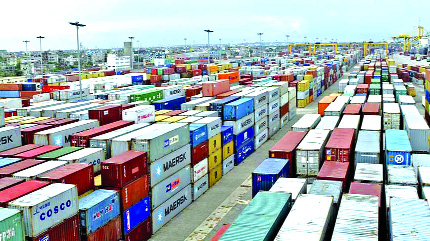
Business Desk :
Trade deficit has surpassed a record $13 billion in the first nine months of this fiscal year, due to higher imports.
The figure is almost double compared to the same period a year earlier, according to data from Bangladesh Bank.
During the July-March period, imports stood at $40 billion and exports fetched more than $27 billion.
During the period, remittances grew about 17 percent to $10.8 billion from a year earlier.
Trade in services has also widened as it stood at $3.03 billion between July and March, up 20.5 percent from the same period a year ago, according to data from the Export Promotion Bureau.
Yet, rising foreign investments and assistance helped make a surplus in the financial account in the first nine months of this fiscal year. From July through March in the current fiscal year, the surplus stood at $6 billion, which was $3.14 billion in the same period a year earlier.
During the period, foreign direct investment was $2.25 billion, compared to $2.4 billion a year ago.
Bangladesh received $3.73 billion as foreign assistance, a sharp increase of 84.55 percent.
The rising trade gap brought the current account deficit to a record level: in the first nine months of fiscal 2017-18, the deficit stood at more than $7 billion in contrast to $1.38 billion a year earlier.
Analysts blamed the surging demand for imports from businesses for the growing imbalance in the country’s external trade. If the trade imbalance gets stronger, it might have a negative impact on the foreign exchange reserves and lead to the further devaluation of the local currency against the greenback.
Trade deficit has surpassed a record $13 billion in the first nine months of this fiscal year, due to higher imports.
The figure is almost double compared to the same period a year earlier, according to data from Bangladesh Bank.
During the July-March period, imports stood at $40 billion and exports fetched more than $27 billion.
During the period, remittances grew about 17 percent to $10.8 billion from a year earlier.
Trade in services has also widened as it stood at $3.03 billion between July and March, up 20.5 percent from the same period a year ago, according to data from the Export Promotion Bureau.
Yet, rising foreign investments and assistance helped make a surplus in the financial account in the first nine months of this fiscal year. From July through March in the current fiscal year, the surplus stood at $6 billion, which was $3.14 billion in the same period a year earlier.
During the period, foreign direct investment was $2.25 billion, compared to $2.4 billion a year ago.
Bangladesh received $3.73 billion as foreign assistance, a sharp increase of 84.55 percent.
The rising trade gap brought the current account deficit to a record level: in the first nine months of fiscal 2017-18, the deficit stood at more than $7 billion in contrast to $1.38 billion a year earlier.
Analysts blamed the surging demand for imports from businesses for the growing imbalance in the country’s external trade. If the trade imbalance gets stronger, it might have a negative impact on the foreign exchange reserves and lead to the further devaluation of the local currency against the greenback.

